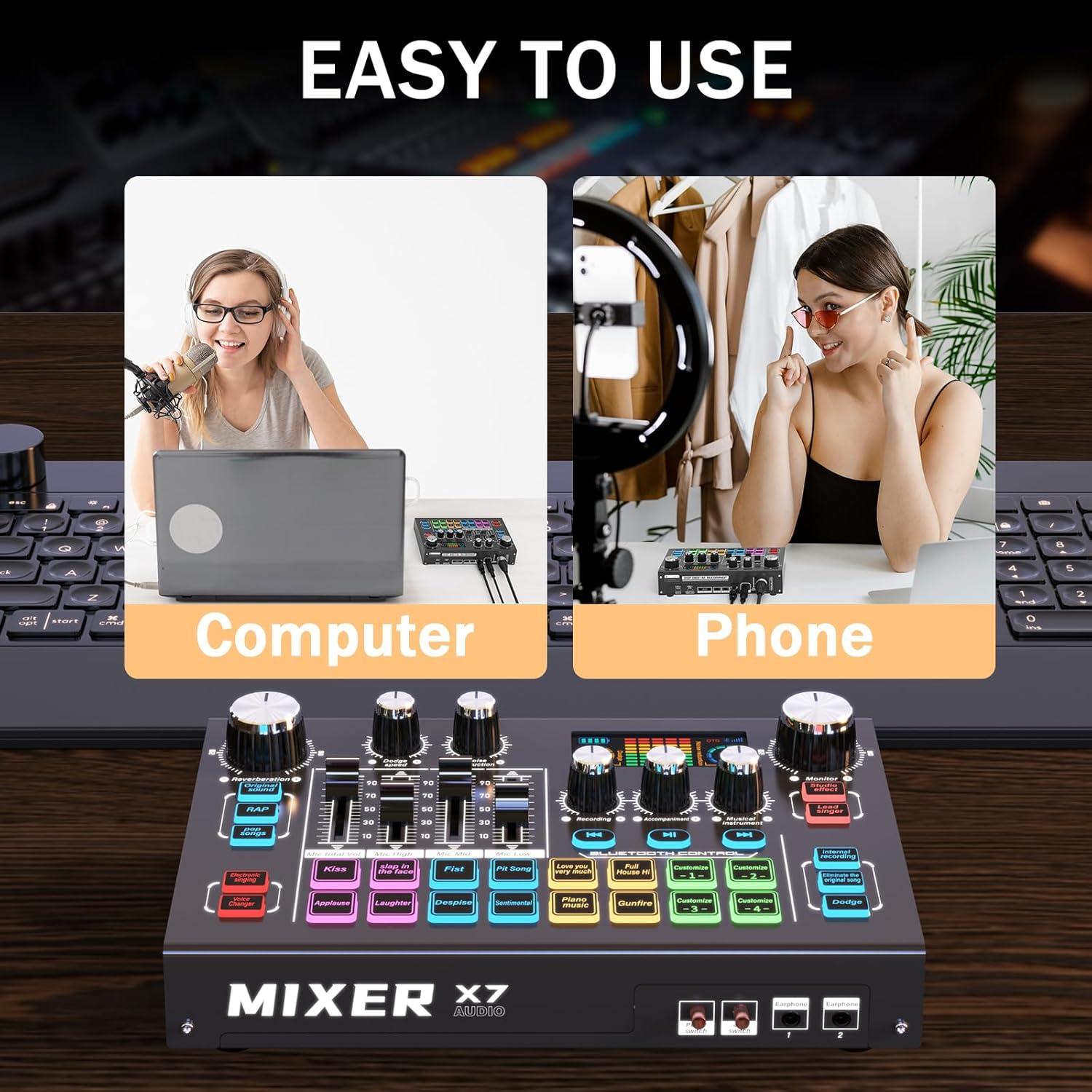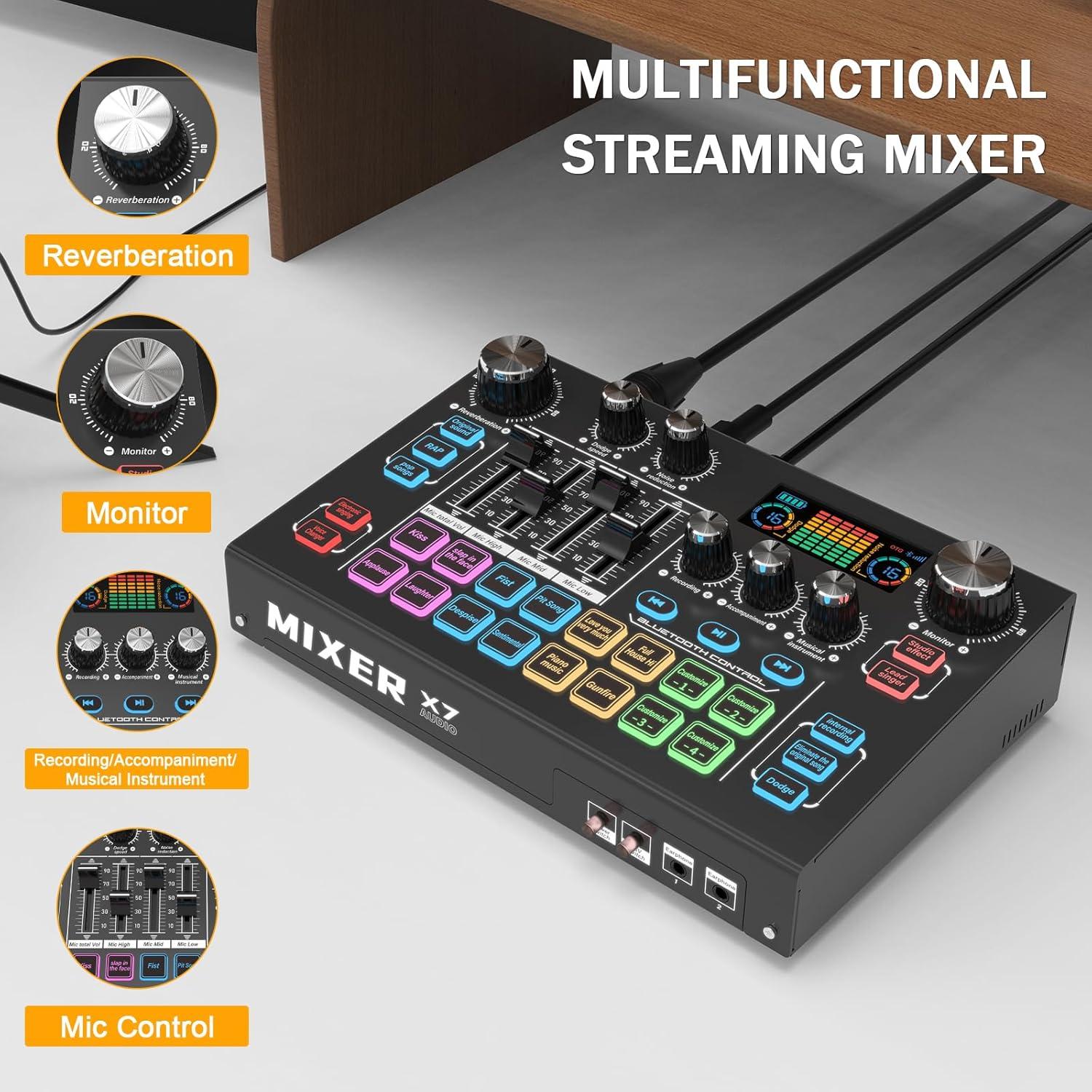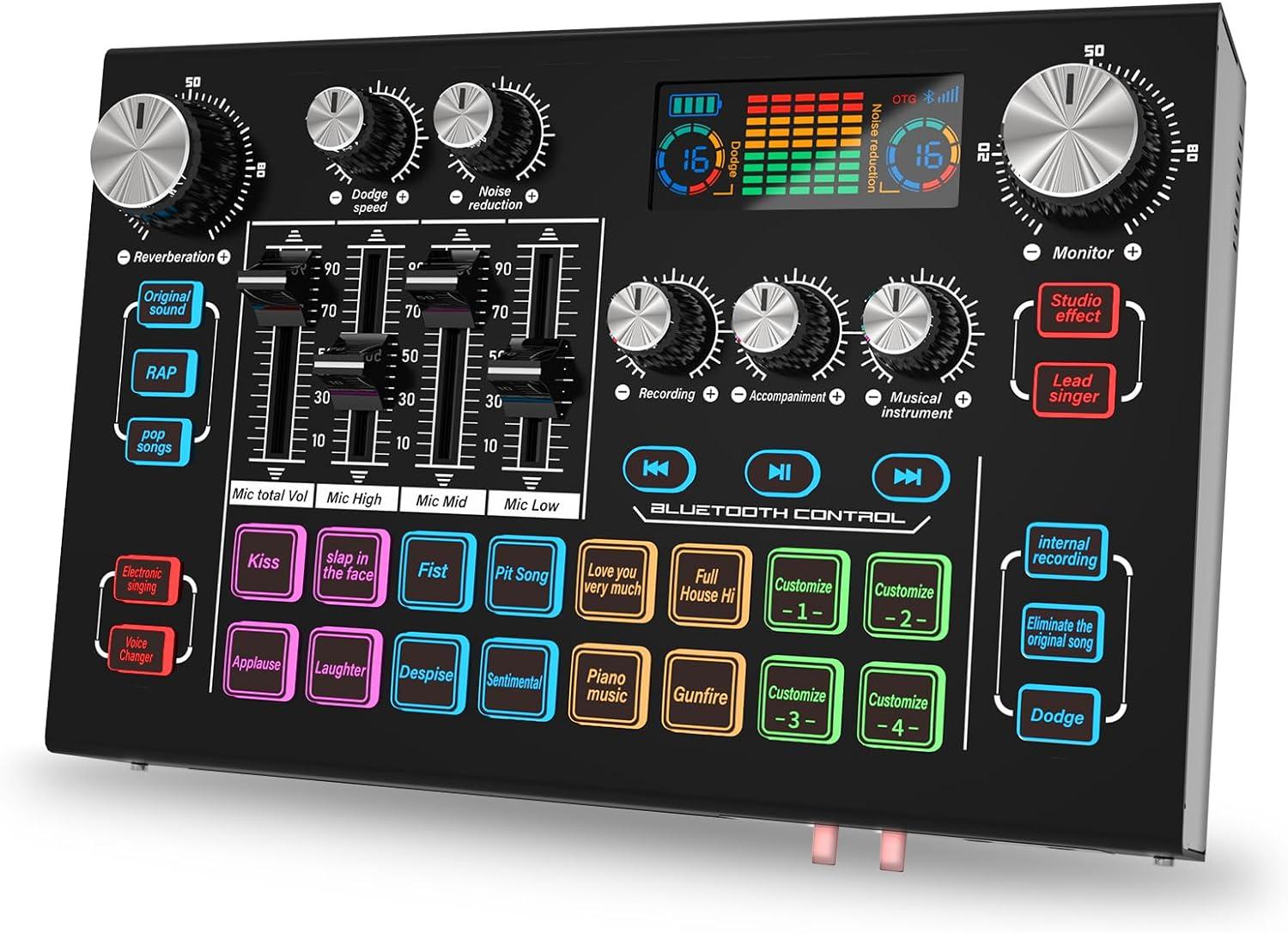When we first unboxed the RHM X7, the weight and metal chassis set the tone: this isn’t a toy,it feels built to work. Right away the XLR input and 48V phantom switch made it clear this little mixer was aiming to bridge the gap between portable convenience and pro-style features. Over the last few weeks we’ve taken it to home studio sessions, livestreams, and impromptu street interviews to see whether its promise of clearer sound, voice effects and battery-powered portability holds up in real use.
On paper the X7 is a busy little box – five independant faders, an XLR mic interface, 16 sound effects (12 presets plus four customizable buttons), four voice-change modes, an LCD to show noise-reduction and dodge-speed levels, and a 3,000mAh battery rated for about eight hours. It also touts adjustable noise reduction and an auto-mute “dodge” function so backing music steps aside when you speak – features that caught our attention for streaming and singing setups where clarity matters. We also wanted to see if the advertised ease-of-use and cross-platform compatibility (iOS, Android, Windows, macOS) made setup truly plug-and-play. In this review we’ll walk through how the X7 handled real microphones and phones, how intuitive the controls felt during live streams, and whether the voice-change and effect options add creative value or just clutter. We’ll look at build quality, sound fidelity through the XLR/phantom chain, battery practicality on the go, and how well the dodge and noise-reduction systems actually clean up a noisy habitat. If you’re considering the TY01 as a compact audio solution for podcasting, streaming, or mobile recording, read on – we put it through the kinds of scenarios most creators will face and share what worked, what didn’t, and where this mixer fits in our toolkit.
Our Overview and First Impressions of the Podcast Mixer

Our first impressions leaned toward impressed: the metal chassis feels robust and the sound reproduction is noticeably clear from the moment we powered it up. The built‑in XLR interface and 48V phantom power give us confidence that both condenser and dynamic microphones will sound detailed and true-to-life, while the LCD display and five independent faders make level adjustments immediate and tactile. Key hardware highlights we noticed right away include:
- Solid build: metal body for durability and consistent audio performance
- intuitive control: five channel faders, dedicated knobs for reverb/treble/bass and a clear LCD
- Connectivity: XLR, Bluetooth and supplied cables for quick hookup to phones and computers
| Feature | Quick fact |
|---|---|
| Battery | 3000mAh ≈ 8 hrs |
| Sound effects | 16 total (12 presets + 4 custom) |
| Noise control | 16 levels + dodge auto‑mute |
Setup was straightforward – we turned it on, paired a device, and adjusted levels within minutes. The combination of detailed hardware controls and compact footprint made it feel like a portable studio straight out of the box. See current price on Amazon
How We Explore the Key Features From Phantom Power to XLR Connectivity and Creative Sound Effects

We start by focusing on the fundamentals that shape audio quality in real-world use. In our hands-on tests the 48V phantom power and built-in XLR interface immediately stood out for how reliably they capture nuance – condenser and dynamic microphones both come through clean and articulate when routed through the metal chassis. We also pay close attention to the control surface: the 5 individual channel faders give us precise balance between microphones, accompaniment, monitor and instruments, while the LCD display helps track adjustments at a glance. During live runs we experiment with the 16-level noise reduction and the dodge speed auto-mute: toggling dodge makes background music duck exactly when we speak and resume when we stop, which prevents music from competing with voice in a stream or podcast. To summarize what we test and why, we look for solid construction, low-noise preamps, and clear tactile controls that make mixing feel intuitive.
Next we explore the creative side – the built-in effects and voice tools that keep listeners engaged. The unit combines 12 preset sound effects with 4 customizable buttons (a total of 16 sound effects) and 4 voice-changing modes so we can switch personas, trigger laughs, or craft character voices on the fly. The lead singer vs accompaniment modes are notably useful for vocal streams: only we hear the original track while the audience hears accompaniment, which is ideal for live singing. Portability matters too; its compact metal body, roughly 8.27 × 5.43 × 2.36 inches and light weight, plus a 3000mAh battery that delivers about 8 hours of operation, means we can take a full setup anywhere. Below is a quick specs snapshot we refer to during setup:
| Feature | Quick Note |
|---|---|
| 48V Phantom | Supports condenser & dynamic mics |
| Voice Modes | 4 fun and usable transformations |
| Battery | ≈8 hours for mobile sessions |
- Use cases: livestreams, portable podcasts, mobile karaoke, voiceovers
- Connectivity: Bluetooth or wired via included cables for PC/phone
Hands On Insights and Our Practical setup Recommendations for Streaming Recording and Phone Use

When we first unboxed the unit we noticed the solid metal chassis immediately – it feels built to last and translates to a cleaner audio character when paired with an XLR mic and 48V phantom power. In practice we use a condenser for voiceovers (phantom on), a dynamic for noisy rooms (phantom off), and always start with low gain then bring levels up using the 5 independent faders while monitoring in real time to avoid clipping. The LCD display makes tuning straightforward, and the combination of 16 sound effects and 4 voice-change modes lets us switch moods mid-stream without fumbling. Two features that really improved our live broadcasts are the noise reduction (we usually set it between levels 3-6 for bedroom setups) and the dodge (auto-mute) speed - set to medium for talk-over-music so the accompaniment drops cleanly when we speak. For phone streams we pair via Bluetooth or the included TRRS cable; for the best latency and reliability we prefer the wired TRRS-to-phone route and keep the monitor on for instant feedback.
Practical setup tips that consistently work for us:
- Phone streaming: TRRS cable + moderate noise reduction + dodge enabled.
- Studio recording: XLR condenser, 48V on, low reverb, record clean dry signal.
- Live singing: Accompaniment mode so only we hear the original track while the audience hears accompaniment.
Below is a quick reference table of our go-to settings for different scenarios.
| Use Case | Phantom | Noise Reduction | Dodge Speed / Faders |
|---|---|---|---|
| Mobile Live Stream | Off (dynamic) / On (condensor) | 3-5 | Medium / Balanced |
| Podcast / Voiceover | On | 4-6 | Off / Mic priority |
| Singing / Karaoke | Depends on mic | 2-4 | Fast / music slightly lower |
A few final notes: record custom effects to the four programmable buttons for repeatable show cues, keep the 3000mAh battery topped for ~8 hours portability, and always bring the USB‑C cable and TRRS cable when working on location. Ready to try the setup we used? See the exact setup and buy now
Pros & Cons

Pros & Cons
After spending time with the RHM X7 we came away with a clear sense of where it shines and where it asks for a little patience. below are the highlights that mattered most to us during recording, streaming and on-the-go sessions.
Pros
- Solid metal build: Feels sturdy and gives a reassuring, professional vibe-no rattles during use.
- True mic support: 48V phantom + XLR input let us use condenser or dynamic mics and capture detailed vocals.
- Flexible channel control: Five independent faders made it easy for us to balance mics, music and monitor mixes on the fly.
- Creative tools onboard: 16 sound effects, 4 voice-change modes and dedicated lead/accompaniment options added fun and performance flexibility.
- Smart noise and ducking controls: 16-level noise reduction and adjustable dodge speed (auto-mute music while speaking) cleaned up our live streams.
- Portable with decent battery life: Small footprint and a 3000mAh battery gave us roughly 8 hours of untethered use for impromptu sessions.
- Quick setup: Bluetooth and included cables make it easy to connect to phones, PCs and tablets-good for beginners.
- Clear visual feedback: The LCD helps when dialing in levels or checking noise/dodge settings.
Cons
- Voice effects can be gimmicky: The voice-changing modes are fun, but some settings sound artificial for serious podcasting.
- Bluetooth latency: Wireless pairing is convenient, but it can introduce noticeable latency-we preferred wired connections for live performances.
- Accessory gaps: The box does not include an XLR cable or a USB-C power adapter, so you may need to buy extra leads before going fully live.
- Controls are compact: The small footprint is great for portability, but the layout can feel cramped when making fine adjustments quickly.
- Battery is non‑removable: 3000mAh worked well for a session, but it means you’re tied to the internal cell for long-term life or replacements.
- Not a studio replacement: It improves clarity and control for streaming, but will not replace higher-end audio interfaces for professional studio tracking.
- Documentation & support: The quick start is fine, but we found some advanced features needed trial-and-error-clearer manuals or tutorials would help.
We think the RHM X7 is a strong, feature-packed option for streamers and podcasters who want a portable mixer/interface with creative tools built in. For those prioritizing ultra-low latency monitoring, studio-grade preamps, or a full accessory kit out of the box, you’ll want to plan a few extras before you go live.
| Quick Snapshot | Our Take |
|---|---|
| Build | Metal, feels premium |
| Best for | Streaming, on-the-go podcasts |
| Must-buy extras | XLR cable, spare USB-C charger |
| Dealbreaker? | latency-sensitive workflows (use wired) |
Q&A

Q: Who is the RHM X7 best for?
A: We think the X7 is aimed squarely at live streamers, podcasters and mobile content creators who want more control than a phone app but don’t need a full studio console. It’s especially good for beginners and small teams who want quick setup, voice effects, and on-the-go recordings.
Q: Is it easy to set up and use?
A: Yes. In our testing it was largely plug-and-play: power it on, connect via Bluetooth or the included USB/3.5mm cables, plug a mic into the XLR, and use the intuitive faders and knobs. The LCD helps with levels. There’s a learning curve for features like dodge and noise reduction, but the controls are straightforward onc you play with them.
Q: Can I use a condenser microphone with this unit?
A: Yes.The X7 has 48V phantom power and an XLR input, so it supports both condenser and dynamic mics. As a best practice, we recommend switching phantom power off before plugging or unplugging a mic to avoid pops.
Q: How good is the sound quality?
A: The metal housing and built‑in XLR/48V support give the X7 a solid, clean sound for streaming and podcasting.It’s not a high‑end studio interface, but in our experience it delivers clear, usable audio-especially for live broadcasts and voice work.
Q: What are the voice changing modes and sound effects like?
A: The unit offers 4 voice‑changing modes and 12 preset sound effects plus 4 custom buttons you can record. We found the presets fun and effective for engaging viewers; the custom slots are handy for jingles or recurring bits. They’re great for entertainment and live interaction, though not intended for professional vocal processing.
Q: What is the “dodge” feature and does it work well?
A: Dodge auto‑mutes or attenuates background music when you speak so your voice stays clear. The X7 gives you 16 levels of dodge speed to dial how fast music ducks. In our tests it worked reliably once tuned-just be ready to tweak levels depending on your mic and music source.
Q: How effective is the noise reduction?
A: Noise reduction has 16 levels and an LCD readout. It helped clean up background hum and room noise in our sessions, but you’ll want to find the sweet spot-too aggressive filtering can make voices sound hollow. For best results, combine it with a decent mic and sensible gain staging.
Q: How long does the battery last in real use?
A: The X7 has a 3000mAh battery and claims about 8 hours of use. In our real‑world streaming tests with moderate brightness and Bluetooth active, we saw battery life close to that figure. Heavy use of backlight, Bluetooth and effects will shorten runtime.
Q: Can we use the X7 as a recording interface for DAWs (multitrack)?
A: The X7 is designed primarily as a live mixer/interface for streaming and podcasting. It connects to phones and computers and handles live audio well. If you need full multitrack recording or advanced ASIO routing for professional sessions, a dedicated audio interface would be better. For single‑track capture, voiceovers and livestream recording it performs fine.
Q: Is it portable?
A: Definitely. At roughly 8.27 x 5.43 x 2.36 inches and about 1.84 lb, the metal chassis still keeps it compact and travel‑friendly. We liked being able to take it to different locations without a bulky rig.
Q: What connections are included and what do we still need?
A: The package includes the live sound card, a 3.5 mm TRRS cable, and a USB‑A to USB‑C cable. You get an XLR input with phantom power, Bluetooth connectivity and the usual inputs/outputs for monitor and instruments. You’ll still need your microphone, headphones or speakers, and any adapters specific to your phone (Apple’s Lightning/USB‑C to USB camera adapters) if required.
Q: Any common issues or troubleshooting tips?
A: A few practical tips from our time with the X7:
– If a mic isn’t active, make sure phantom power is on for condensers and the XLR is fully seated.
– On phones, select the X7 as the input device in your streaming app and grant microphone permissions.- If music doesn’t duck properly, tweak dodge speed and noise reduction levels.
– For custom sound effects, use the recordable buttons as directed in the manual and name/organize your clips beforehand.
– If you run into odd behavior, a power cycle and reconnect often fixes it.
Q: Final verdict in one sentence?
A: The RHM X7 is a compact, feature‑rich live mixer that we found to be an excellent value for streamers and podcasters who want phantom‑powered XLR input, on‑board effects and mobile battery operation-while pros needing studio multitrack capabilities may want a dedicated interface.
Ignite Your Passion

We’re glad you stuck with us through this deep dive. In short, the RHM X7 feels like a compact, metal-built Swiss Army knife for streamers: it pairs 48V phantom power and an XLR input for cleaner capture with handy features like five independent faders, 16 sound effects, four voice-changing modes, an LCD for quick feedback, and adjustable noise-reduction + dodge speed. The 3,000 mAh battery and small footprint make it genuinely portable, and the intuitive controls let us get a broadcast up and running quickly.
During our tests the X7 delivered clear, usable audio and a lot of playful options for engaging viewers. We also noticed there’s a bit of a learning curve if you want to customize every effect or troubleshoot connections, so take a minute with the user manual when you first set it up. It’s a versatile option for beginners and on-the-go creators who want more control than a basic USB mic-without the complexity of a full studio board.
If you’re curious to compare specs, read user reviews, or pick one up, you can check the RHM X7 here: see the RHM X7 on Amazon


Reviews
There are no reviews yet.